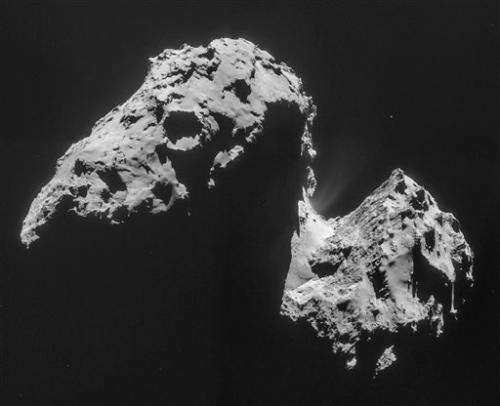The image comprised of four images taken with the navigation camera on Rosetta and released by the European Space Agency ESA on Thursday, Nov. 20, 2014 shows comet 67P/Churyumov-Gerasimenko on Nov. 17, 2014 from a distance of 42 km (26 miles) from the center of the comet. The mystery of where Earth's water came from has gotten murkier, with astronomers essentially eliminating one of the chief suspects: comets. The European Space Agency's Rosetta space probe closely examined the type of comet that some scientists theorized could have brought water to our planet 4 billion years ago. It found water, but the wrong kind.(AP Photo/ESA)
The mystery of where Earth's water came from got murkier Wednesday when some astronomers essentially eliminated one of the chief suspects: comets.
Over the past few months, the European Space Agency's Rosetta space probe closely examined the type of comet that some scientists theorized could have brought water to our planet 4 billion years ago. It found water, but the wrong kind.
It was too heavy. One of the first scientific studies from the Rosetta mission found that the comet's water contains more of a hydrogen isotope called deuterium than water on Earth does.
"The question is who brought this water: Was it comets or was it something else?" asked Kathrin Altwegg of the University of Bern in Switzerland, lead author of a study published in the journal Science.
Something else, probably asteroids, Altwegg concluded. But others disagree.
Many scientists have long believed that Earth had water when it first formed, but that it boiled off, so that the water on the planet now had to have come from an outside source.
The findings from Rosetta's mission to the duck-shaped comet 67P/Churyumov-Gerasimenko complicate not just the question of the origin of Earth's water but our understanding of comets.
Until now, scientists pretty much sorted comets into two types: near and far. The near ones, sometimes called the Jupiter family, originally come from the Kuiper Belt outside Neptune and Pluto. The far ones hail from the Oort Cloud, which is much farther out.
In 1986, a spacecraft came within about 400 miles (640 kilometers) of Halley's comet, an Oort Cloud comet, and analyzed its water. It proved to be heavier than Earth's water. But three years ago, scientists examined the water in a Kuiper Belt comet, Hartley 2, and it was a perfect match for Earth's water, so the comet theory was back, stronger than ever, Altwegg said.
The comet visited by Rosetta is a Kuiper Belt comet, but its water was even heavier than Halley's, Altwegg said. That shows that Kuiper Belt comets aren't as uniform as thought, and it once again complicates the issue of Earth's water.
"That probably rules out Kuiper Belt comets from bringing water to Earth," she said.
University of Maryland astronomer Michael A'Hearn, who wasn't part of the research, called the results startling but said they don't eliminate comets altogether. The water could have come from other types of Kuiper Belt comets, he said.
NASA Near Earth Object program manager Donald Yeomans, however, thinks it does pretty much rule out comets.
While asteroids are a good suspect—they probably had more water on them 4 billion years ago than they do now—another possibility is that Earth kept some of its original water in its crust or in ice at the poles, Altwegg said.
More information: 67P/Churyumov-Gerasimenko, a Jupiter family comet with a high D/H ratio, Science DOI: 10.1126/science.1261952. www.sciencemag.org/content/ear … 2/09/science.1261952
ABSTRACT
The provenance of water and organic compounds on the Earth and other terrestrial planets has been discussed for a long time without reaching a consensus. One of the best means to distinguish between different scenarios is by determining the D/H ratios in the reservoirs for comets and the Earth's oceans. Here we report the direct in situ measurement of the D/H ratio in the Jupiter family comet 67P/Churyumov-Gerasimenko by the ROSINA mass spectrometer aboard ESA's Rosetta spacecraft, which is found to be (5.3 ± 0.7) × 10−4, that is, ~3 times the terrestrial value. Previous cometary measurements and our new finding suggest a wide range of D/H ratios in the water within Jupiter family objects and preclude the idea that this reservoir is solely composed of Earth ocean-like water.
Journal information: Science
© 2014 The Associated Press. All rights reserved.
























